- Administrator
- Albums and Singles
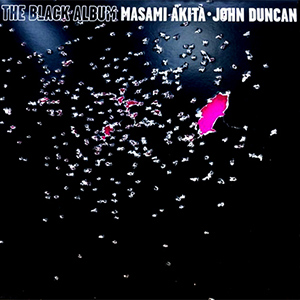 The title of this (surprisingly first) recorded collaboration between Akita and Duncan certainly conjures images of similarly titled works that are regarded for their brilliance (Prince), or drastic shifts for the worst (Metallica). Other than the fact that it is the first work between these two legendary artists, it does not carry the same monolithic weight sonically. It is, however, still a powerful collaboration that reflects both artists’ strengths quite well.
The title of this (surprisingly first) recorded collaboration between Akita and Duncan certainly conjures images of similarly titled works that are regarded for their brilliance (Prince), or drastic shifts for the worst (Metallica). Other than the fact that it is the first work between these two legendary artists, it does not carry the same monolithic weight sonically. It is, however, still a powerful collaboration that reflects both artists’ strengths quite well.
Details and specifics are scant on this LP, with three untitled pieces (one comprising the entire A side, the other two on the flip) and the only bit of credits specifying the two worked with Duncan’s recordings of the Gran Sasso Nuclear Laboratory.That alone of course arouses curiosity.The A side is a swarm of stammering, stuttering glitches and surging bits of noise.It takes on a sort of insane, malfunctioning computer feel with shrill squeaks and erratic bursts.
It obviously is dissonant and seemingly formless, but the amount of layering and variety and moderate volume levels make it completely listenable.As it goes on it becomes a wet, sloppy series of bursts.The ending focuses more on crunchy noises and tactile textures.
The first piece on the B-side ends up being more traditionally harsh noise in its composition.Layers of grinding, scraping, and sputtering noises stay relatively constant as it goes on.The sound is not as erratic or messy as the other side, instead has a nice, tight feel and flow to it.Between this and the crackly passages of static, it stays engaging rather than becoming a test of endurance.
The other piece harkens back to the skittering glitches of the A side, but with a deep echoing throb and high pitched, sharp and spiny layer.With these elements encasing around a heavy machinery-like drone (perhaps the untreated source material), it is almost a boisterous piece of ambient music, giving needed space and smoothness later on.
The monochromatic title of Akita & Duncan's work might hide the actual diversity of sound here, but the unique packaging and artwork does anything but.The stark black cover features a nice die cut job via a shotgun blast, revealing the bold, glossy pink inner sleeve.Within that sleeve the vinyl sits nicely in its intensely green glory.It might not reinvent the wheel, but it is a high water mark in both artists’ discographies, and is a befitting, complex work from two distinguished composers.
samples:
 
Read More
- Administrator
- Albums and Singles
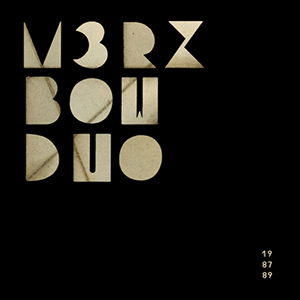 At first I was not sure how this box set slipped by me when it was released last year, but then I remember this is Merzbow we are talking about. He puts out more boxes in a year than most artists do single albums. This is one, however, that should not have gone overlooked. As indicated by the title, this is Masami Akita not alone, but with Kiyoshi Mizutani, and consists of ten discs of raw improvised sessions recorded between 1987 and 1989. Deeply entrenched in the Akita’s junk noise phase, it a sprawling, yet captivating document of the best years of Merzbow.
At first I was not sure how this box set slipped by me when it was released last year, but then I remember this is Merzbow we are talking about. He puts out more boxes in a year than most artists do single albums. This is one, however, that should not have gone overlooked. As indicated by the title, this is Masami Akita not alone, but with Kiyoshi Mizutani, and consists of ten discs of raw improvised sessions recorded between 1987 and 1989. Deeply entrenched in the Akita’s junk noise phase, it a sprawling, yet captivating document of the best years of Merzbow.
These sessions acted as raw materials for some Merzbow releases of the era, such as S.C.U.M., but here are recordings without the tape edits or further processing.This is just two men and a slew of instruments (traditional and otherwise) improvising in the studio for hours.Because of that, it does inch towards overkill since it documents the source material that was intended for further treatments.It is a voluminous collection (well over ten hours), but taken in bite sized chunks remains extremely enjoyable.
At times, the recordings come together more like extremely unconventional free jazz:"Duo 1987" is a blend of harshly bowed strings that could almost be manic duck calls with junky percussion.The combination almost resembles a horn/drum duo as far as sound goes, but is far more dissonant and pleasantly ugly."1 May 1988 A" has the same feel, but this time via rapid guitar noodling and rhythmic variations.Finally, "20 September 1987" is another bird of the jazz feather.What sounds like a bass guitar and random metal percussion paired up as if Akita and Mizutani tried to recreate Ornette Coleman's "Free Jazz" with whatever they could find at a junkyard.After a bit of organization they give up and just bang away jovially, with a loose and almost fun vibe to be had.
Other skewed attempts at making music show up throughout the set as well.The second part of "16 April 1989" leans not into jazz, but rock.What begins with someone screwing around on a guitar and a percussion section that sounds like flicking an empty soda can builds into a full on improvised guitar and drum performance, leading into a mass of sludgy stoner metal.The bit of straight up "music" works brilliantly amongst the otherwise pure dissonance and noise that has characterized Merzbow.
As expected, much of the recordings in this set are less structured and more chaotic masses of sound.Due to the duo working with a wide variety of instruments and effects, however, it never devolves into the mass of distortion pedal generated dull roar that blended much of Merzbow's output in the 1990s into a dull blur.High pitched feedback and electronic bursts on "19 June 1988 Part 1" are quite harsh, but the noisy metal percussion gives it additional depth.The second half of the piece accentuates the more piercing noises into a painfully shrill work without any clearly discernible source as far as instrumentation goes.
Metal scraping and distorted effects make up much of "25 June 1988 A", but the layering and density is not as intense, and with the addition of guitar it is more diverse than contemporary work from Akita."9 October 1989 Part 3" features the same array of cheap, probably broken effects pedals, with an almost sitar-like passage and a wonderfully sloppy start/stop structure that helps it to stand out.
The limited Art Edition of the Duo box features an 11th disc that is a bit odd compared to the rest, dating back to November 1979.While it is pretty far removed from the rest of the set's timeline, it still is a collaborative recording between the two.With Akita on drums and Mizutani manning the keyboards, it is a 41 minute improv that may be a bit self-indulgent, but its transitions from jazz to disco and into psychedelic rock are fascinating, even more so considering what Akita has been involved in for the 35 years since then.
Masami Akita's work as Merzbow from the project’s inception until the late 1980s has always grabbed my attention the most diverse and engaging.For that reason, I was extremely eager to hear this set, and was not disappointed.The variety of sounds and instrumentation is so much more pleasing and captivating than his later penchant to just crank a bunch of pedals up as loud as possible and repeating for hours.Essentially being unedited, it might lack the focused impact of Ecobondage or Batztoutai With Material Gadgets, but the untreated recordings are fascinating in their own right.Unquestionably one of the top tier Merzbow releases of all time.
samples:
 
Read More
- Administrator
- Albums and Singles
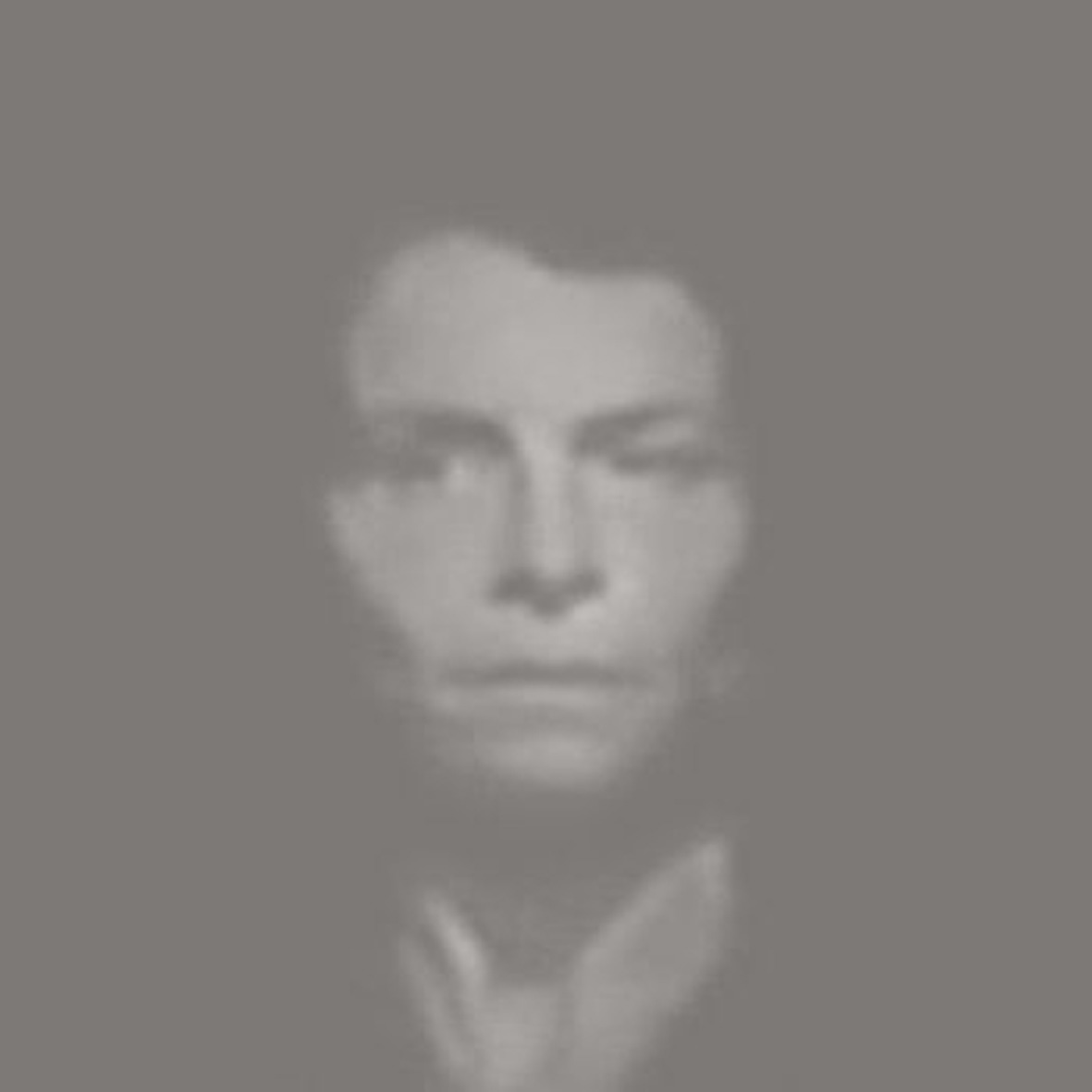
Although released concurrently with Tombs by Denovali, Loss is actually London engineer/musician Tim Garratt's second effort as Moon Zero.  While it shares Tombs’ unique approach of being composed and recorded entirely in an empty church, Loss is the fruit of Garratt's attempt to transform his aesthetic into something that he could perform live, resulting in a much more muscular, rhythmic approach without sacrificing much of the ghostly ambience that made his earlier compositions so compelling.  At its best, Loss resembles something like a rawer and more spontaneous Tim Hecker with a few very cool tricks up his sleeve.
The opening "Youth" captures Garratt at his most Hecker-esque, as a muted, melancholy organ melody floats like a fog while an escalating rumble builds beneath it and ghostly swells start to reverberate from the church's walls (the church being London's St. George in the East).  Ultimately, the piece builds to an impressively shuddering roar before quickly dissipating at the perfect moment, achieving an impressive convergence of mood, texture, and dynamics.  The following piece, "Nosema Cerenae," is an increasingly sinister-sounding bit of organ drone that fleetingly recalls Charlemagne Palestine or Catherine Christer Hennix, though Tim beautifully embellishes that intentional/unintentional homage with a roiling bass rumble, some fierce crackle, buried snatches of angelic vocals, and–most brilliantly–a brief surge of deep, absolutely tortured-sounding noise snarl.  As a whole, "Nosema" is not quite as strong as "Youth," but the demonic, overloaded noise snarl might stand as the best single moment on the album, as it feels like something deeply unholy is trying to tear its way out of my speakers.
Garratt nicely escalates the momentum for the second half with "Lara Witchcraft," where he quickly transforms pulsing synth and organ rhythm into something that resembles a lumbering, massive machine-noise waltz that is always precariously on the verge of tearing itself apart. After that impressive show of force, Loss winds down its conclusion with its longest piece, "The Industrial Sadness," which clocks in at around 8-minutes of deep, throbbing synth hum beneath a series of forlorn moans.  To my ears, it is by far the EP's weakest piece, as there is not any melody or chord progression to speak of–just a whole lot of vaguely eerie sci-fi atmosphere and some impressively heavy machine crunch near the end.  Unfortunately, all that power goes to waste, as it is not used to bolster an already compelling motif nor does it become particularly hypnotic or transform into something else.  It just escalates in force, then abruptly ends.
"The Industrial Sadness" aside, however, Loss is a damn near perfect effort (albeit quite a brief one), as each of the first three pieces is powerful, distinctive, unpredictable, and deftly executed.Tim Garratt clearly knows how to get the most out of an idea and has an intuitive knack for exploiting a single strong motif and ending the piece before it starts to drag. Also, while a number of clear influences come to mind, Tim definitely uses them a mere jumping-off point rather than as a template (and I seem to like all of the same artists that he does, which helps too).  Probably Garratt's greatest achievement here, however, is his work as a producer/engineer.  Recording in a church means far more than just getting some great natural reverb, as the unusual acoustics can easily swallow some sounds, unexpectedly sharpen others, or cause various parts of the church to intensely vibrate at certain frequencies.  Despite that, Garratt somehow managed to wrangle all those untamed site-specific acoustics into something that sounds deliberate, massive, and visceral on a home stereo.  That must have taken forever, but it was worth the effort.
 
Read More
- Administrator
- Albums and Singles
 What began as a lighter side project to Richard Chartier’s more academic work under his own name has evolved into its own distinct entity. Featuring some high profile vocal collaborations, including William Basinski, Cosey Fanni Tutti, and Kid Congo Powers, Description of Problem has Chartier expanding his kitchy project even further, into a dark, sexy album that adds another glittering jewel into his discography.
What began as a lighter side project to Richard Chartier’s more academic work under his own name has evolved into its own distinct entity. Featuring some high profile vocal collaborations, including William Basinski, Cosey Fanni Tutti, and Kid Congo Powers, Description of Problem has Chartier expanding his kitchy project even further, into a dark, sexy album that adds another glittering jewel into his discography.
At times, PCP stays somewhat close to Chartier's own work.Opener "Description of Problem/More Everything", with Aurora Liminalis collaborator William Basinski appearing via voicemail, is not too far removed from what appeared on that album:glistening, shiny melodies and electronic interference in an otherworldly haze.The lower fidelity moments and sampled voices are what gives it a distinct character compared to his other works."Perfunctory Attachments," the only one here that is Chartier alone, follows a similar pattern and style.The voice samples and haunting melody ensures it remains distinct from his other material, but his expert use of understated electronics is clearly present.
One of the most significant developments from the previous PCP albums comes on "Our Story," featuring vocals by AGF.The piece retains the Valium haze of the other album, but here Chartier employs an almost percussive bass throb that evolves into a crunchy, distorted pulse.The appearance of scattered melodic shards in the beginning and end keeps it clearly a PCP release, but his flirtations with rhythm are refreshing.
The album's centerpiece is a dark and captivating collaboration with Cosey Fanni Tutti titled "Boundlessly (for M. Heyer)".Chartier keeps the noises low and rumbly throughout, with creepy bits of melody and crumbling sound textures that enhance the impact of her voice.Cosey’s spoken vocals are hushed and intimate, and while the content of the lyrics may be disturbing, she brings an undeniable sensual mood that is beautifully matched with the lush electronic backing.
Gun Club/Cramps member Kid Congo Powers appears on a reworking of PCP’s "iamaphotograph (darkroomversion)", which appeared previously on Please Pick Up.On here it is pulled apart and disjointed even more, with Powers' male voice standing out forcefully in the contexts of the otherwise feminine voices that dominate the album.The result is an ugly and intimidating bit of animus amongst the anima that comprises Description of Problem.Even though it is more fragmented in comparison, it has the same dark filthy ambience that characterized the previous versions, and takes downright sonically evil turn at the end.
The aesthetic Richard Chartier has developed as Pinkcourtesyphone may bear little resemblance to the serious, scholarly work that he issues under his own name, but it features the same level of compositional skill and complexity that sounds like no other.The underlying theme of vintage camp and ennui results in an juxtaposition with the dark sexuality and hints of sleaze that permeate the album, resulting in a genius reality versus fantasy pairing befitting the 1950s housewife sensibility PCP has featured heavily in his albums thus far.
samples:
- Description of Problem (with William Basinski)/More Everything
- Our Story (with AGF)
- Boundlessly (for M. Heyer) (with Cosey Fanni Tutti)
 
Read More
- Administrator
- Albums and Singles

Although I absolutely loved 2011's Crossing the Pass, By Torchlight album, I had a hard time keeping up with the flood of divergent releases Brian Pyle has unleashed over the last year or so.  As far as I can tell, however, Melt Into Nothing continues along Fever Logic’s path towards darkwave and '80s goth, which is a very curious move.  As noted by Denovali, that arguably makes this Pyle’s most accessible album, but only because it has some vocals and occupies a niche that some people are interested in right now.  In a broader sense, however, I think Brian's weirder, more abstract material is much more attention-grabbing and rewarding than any of the mostly forgotten bands that he is paying homage to here.  That said, Pyle is not one to go for mere pastiche and he still managed to strikes gold with at least one piece.
That one unquestionable success, "Your Lips Against Mine," conveniently opens the album.  In a broad sense, it is not terribly different from the rest of the album, approximating a dreamy/hazy/shoegazy take on melancholy 4AD-style goth pop, but the presence of guests DenMother and Sophia Hamadi make a dramatic difference hook-wise.  DenMother's soft vocals, for example, imbue the piece with a very sensuous (if bleary) Romanticism, while Sophia Hamadi's burbling, ascending synth motif gives the piece a propulsive sense of forward motion.  If Pyle were completely absent, it would probably still be a perfectly enjoyable bit of synthpop heaven.  Taking a good song and then Brian Pyle-ing the hell out of it seems to be an excellent recipe for success, but that first bit is generally missing for rest of the album.  Pyle tends to work best when he has a collaborator or creative foil, as he does in his new Naked Islands project–he is definitely more of an idea man/studio wizard than a hit machine.
Unfortunately, Brian's collaborators are generally absent for rest of Melt, which proves to be a bit exasperating: the textures and details are often quite wonderful, but they tend to be in service of pieces that sound like lesser bands from a '90s Projekt compilation.  For the most part, the remaining songs are a hookless array of near-instrumentals featuring plodding drum machine rhythms, funereal organs, echoing guitars, and a bleary haze of heavily processed vocals and subtly employed field recordings.  "Fade For Miles" comes closest to being an actual song, as it features a comparatively upbeat groove and fairly prominent vocals, though Brian's singing is too floating and hallucinatory to approximate anything like a melody or hook.  There are some nice touches though, as the guitar moans sound wonderfully tortured and the drums unexpectedly become backwards near the end.  I just wish there was more actual content to the song.  "Make Out in the GDR" is another stand-out, bolstered by eerie female dialogue snippets, warped synth, and gnarled guitars.  Again, however, it is far more of a stylistic triumph than a great song.
The remaining songs are all different flavors of "dirge," though the woozy, narcotic guitars in "Hey Baby" constitute another minor album highlight.  Ultimately, however, Melt Into Nothing is a somewhat disappointing and frustrating effort as whole, particularly after such a promising opening.  I suppose Pyle's goth pastiches are a bit better and more imaginative than most music in that vein, but they are not nearly as compelling as the better Ensemble Economique albums.  Though this will probably appeal to some other people a lot more than it resonates with me, this no-man's land between abstract experimentalism and retro-goth is not a particularly fertile place for Brian's impressive talent to flourish.
 
Read More
- Administrator
- Albums and Singles
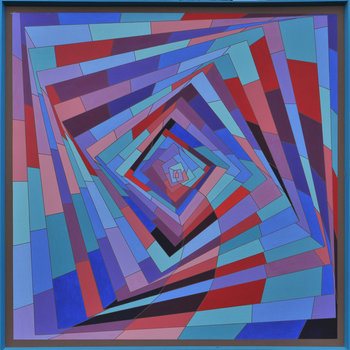 John Everall's name will be familiar to many long-time readers of Brainwashed. He was first known to many of us as a contributing writer to The Wire (see Obscure Mechanics interview with Coil), he operated the Sentrax record label since 1992 (featuring releases by Lull, Final, God, and others), and has been making music mainly as Tactile. John was diagnosed recently with terminal stomach cancer. A compilation has been arranged to help with expenses. Everall By Everall features Stephen Thrower, Drew McDowall, Christoph Heemann, Andrew Liles, Irr.App.(Ext.), Hoor-Paar-Kraat, and many more. All funds received will go to paying for John's funeral expenses when he passes on. Donations are accepted and the compilation can be found at everall.bandcamp.com
John Everall's name will be familiar to many long-time readers of Brainwashed. He was first known to many of us as a contributing writer to The Wire (see Obscure Mechanics interview with Coil), he operated the Sentrax record label since 1992 (featuring releases by Lull, Final, God, and others), and has been making music mainly as Tactile. John was diagnosed recently with terminal stomach cancer. A compilation has been arranged to help with expenses. Everall By Everall features Stephen Thrower, Drew McDowall, Christoph Heemann, Andrew Liles, Irr.App.(Ext.), Hoor-Paar-Kraat, and many more. All funds received will go to paying for John's funeral expenses when he passes on. Donations are accepted and the compilation can be found at everall.bandcamp.com
Read More
- Administrator
- Albums and Singles
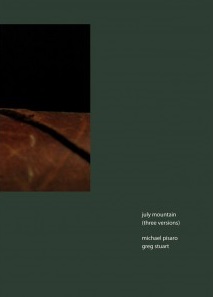 Wallace Stevens wrote "July Mountain" in the last year of his life, suffering from stomach cancer. A recognition of mortality and imperfection hides in his poem’s first eight lines. They gently and beautifully remind the reader that life on earth is a fragmented thing, and that there are no conclusions, no full and final stops that shine a light on all the dark corners in the world. Instead we are all "thinkers without final thoughts in an always incipient cosmos," forever watching the world and the stars spin themselves into new configurations. The poem explicitly uses music as an image for that interminable metamorphosis, and Michael Pisaro’s composition of the same name demonstrates just how apt an image it is. July Mountain (Three Versions) illustrates Stevens’s contention, combining field recordings with incredibly stealthy musical contributions provided by Greg Stuart. Bowed snare drums, piano, bird calls, jet engines, and numerous other sounds, from sine tones to insects, unexpectedly coalesce over its 21 minutes, forming a quivering and effervescent peak for anyone willing to make the ascent.
Wallace Stevens wrote "July Mountain" in the last year of his life, suffering from stomach cancer. A recognition of mortality and imperfection hides in his poem’s first eight lines. They gently and beautifully remind the reader that life on earth is a fragmented thing, and that there are no conclusions, no full and final stops that shine a light on all the dark corners in the world. Instead we are all "thinkers without final thoughts in an always incipient cosmos," forever watching the world and the stars spin themselves into new configurations. The poem explicitly uses music as an image for that interminable metamorphosis, and Michael Pisaro’s composition of the same name demonstrates just how apt an image it is. July Mountain (Three Versions) illustrates Stevens’s contention, combining field recordings with incredibly stealthy musical contributions provided by Greg Stuart. Bowed snare drums, piano, bird calls, jet engines, and numerous other sounds, from sine tones to insects, unexpectedly coalesce over its 21 minutes, forming a quivering and effervescent peak for anyone willing to make the ascent.
July Mountain first appeared as a single piece on a limited edition CDr released by Engraved Glass. To the "California Version" presented on that disc, the Gravity Wave release features two additional performances. One of them, the "Austin Version," is a complete rendition, combining 20 field recordings unique to that city with 10 layers of percussion recorded by Greg Stuart. Instructions for how the field recordings are to be obtained are minimal (make 20 of your own, or get them from the composer, just make sure to point the microphones at mountains or valleys if possible), but their durations and their arrangements with respect to one another are very well defined. They are all ten minutes long, and there are only ever ten recordings playing simultaneously.
On the percussive side, the featured instruments include resonating surfaces teased by sine waves, vibraphones wrapped in tin foil, and "seed rain," a steady stream of seeds, rice, or beans poured over crotales or a glockenspiel (the score gives the performer plenty of choices). Their timings and durations are specified by time markers—four bowed wooden blocks at nine and a half minutes, one projected sine tone at five and a half minutes, lasting for seven minutes and thirty seconds—and the methods suggested for playing them, including the exact qualities to be elicited from them, are described rather than strictly notated. For example, the instructions for the bowed snare drum read, in part, "Sounds may be created by bowing on any part of the instrument and by bowing on a drumstick or doweling with its tip pressed against the drum."
In combination, these two elements are difficult to separate. Conglomerations of sound rise and fall together, smearing into agreement as they are carried away on the same breeze, cars buzz anonymously down lonely roads, storms rumble in the distance, and unidentifiable particles of noise slip in and out of earshot as naturally as the hum of traffic or the rush of wind through the leaves. No hint of instrumental interference is evident until some eight minutes into the song, when the first piano chord sounds. Greg Stuart has actually been playing for six minutes by that point, but it’s not easy to ascertain what belongs to him and what belongs to the mountains of California.
The "Instrumental Version," which omits all the field recordings, renders the extent of this subterfuge with shocking clarity, and is in some ways responsible for making July Mountain (Three Versions) such an eye-opening and enjoyable document. On its own, the music is lovely and unassuming. No matter how thick and confusing the recording becomes, the atmosphere stays spacious and inviting. It drifts without meandering, gradually gains density, and then slowly fades away, as if every element outlined in the composition had been captured all at once, completely by accident. Listening to the "Instrumental Version" adds insight, and a chance to hear how Pisaro and Stuart make the magic happen. It’s exciting to peak behind the curtain and get some sense of the process.
Pisaro’s decision to include the final line of Stevens’s poem in the liner notes provides nearly the same kind of insight, though what it reveals is less technical and more poetic. Just as "Vermont throws itself together" as Stevens climbs the mountain, so too does July Mountain take shape as it is recorded, performed, and heard. Even with all the elements of the instrumental score cemented by a recording, a near infinite variety of performances is possible, each one an accumulation of local sensations captured and sent into orbit, together forming a constellation of perceptions. The work of the composer is discernible upon inspection, but the performance of the piece demands variety. No final mix follows, there’s no signature on the dotted line; it’s an ever-evolving network of coincidences, revelations, and possibilities. July Mountain comes together as we listen to it, maybe as all songs do. But as a composition it asks that we take shape with it. When the sounds finally stop, it must be that something in ourselves stops with it.
samples:
 
Read More
- Administrator
- Albums and Singles
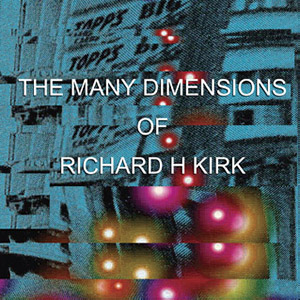 With the reissue of the Cabs' mid-period work last year and Richard H. Kirk's revival of the name for some upcoming performances, this boxed set arrives at just the right time to help brush up on his voluminous solo projects. Compiling three albums released digitally in the past few years, it does an exceptional job at capturing at least part of his multiple personalities, and if nothing else demonstrates just how relevant he continues to be.
With the reissue of the Cabs' mid-period work last year and Richard H. Kirk's revival of the name for some upcoming performances, this boxed set arrives at just the right time to help brush up on his voluminous solo projects. Compiling three albums released digitally in the past few years, it does an exceptional job at capturing at least part of his multiple personalities, and if nothing else demonstrates just how relevant he continues to be.
Given that these three albums have all been available individually via various digital music services for the past few years, this set may be a bit less essential for some than others.Since I am not at all a fan of digital music distribution, I never picked up any of these albums individually, so this was all new to me.The 1960s compilation record titling is fitting, because it serves the same purpose without being a superfluous greatest hits record.
Reality is Opposite is the sound and style that I most associate with Kirk's post-CV career. Noisy samples, hard hitting beats, and cut up voices have been the bread and butter of his projects for years, and this disc heavily features all of it.His penchant for bent funk is all over these eight songs, from the guitar loop of "The Ghetto Child" to the wah-wah heavy effects on "The Young Men Have Guns."Pieces like "Make It On Down" and "Walkin Around" feature a sampled jazz drum loop, dropping the tempo on the latter and giving both a more than just straight-forward techno sound.
He pulls back the club friendly structures somewhat throughout, such as his decision to deeply bury the drums of "Tune In/Turn Off/Care Less," and the beat-less synth expanse of "New Level of Threat."The stripped down sequencing and heavy bass on "The Future Rising" stood out to me like a throwback to the early CV singles, updated with modern sounds but keeping that old, playful experimentation intact.
 
samples:
Umladen, as Orchestra Terrestrial, has Kirk dropping the beats and funk for a less contemporary, more 1970s sounding krautrock synth excursion."Feierlichkeit" is presented with vinyl surface noise atop pulsing bass and basic, melodic synth sweeps, resulting in a pensive, somewhat dour piece that heavily contrasts the militant thump of Reality is Opposite.Kirk factors a bit more rhythm into the equation on "Umladen" and "Zivil," although in the form of bleeping synth sequences rather than big beats.The latter’s inviting, almost catchy feel immediately made me think of '70s Kraftwerk covered in modern grime.
"Autoschlepp" also focuses on a modern ambient electronic sound, admittedly via a bitcrushed melody that keeps it just the right side of weird."Observatorium" and "Prophezeien" are built upon gentle passages of white noise and downtempo synth strings, especially on the former.They would fit in quite well as soundtrack work, but stand nicely on their own as well.
 
samples:
The final disc, Anonymized (via Richard H. Kirk and the Arpeggio 13), sits somewhere between the other two in terms of mood:the overt use of arpeggios maintains a sense of rhythm throughout, but in some cases they are so stretched out/processed the structure is almost invisible.Songs like "Gun Step Funeral Charge" are all jagged, clicky blips of synth noise that excel in their repetition and abrasiveness."Inclement Weather" has Kirk transforming the rapid notes from rhythm to melody as they become more elongated and processed.
"Those Officers" is an example of where the structuring becomes less about rhythm and more about mood and texture, with the arpeggiator allowing the tones to stretch out more."Shore Up the Defences" and "Uprising," on the other hand, sound heavily rooted in 1970s science fiction television:the simple bleeps and note progressions scream "this is the future because we are using synthesizers".This might give both a certain nostalgic value, but makes for dated sounding music.
Of the three, I found Reality is Opposite to be the most enjoyable, largely because it fits in closest with my previous experience with Kirk's work.That modern, updated take on 1970s American revolutionary imagery fits perfectly with current social conditions in the US, as does most of his favorite themes.The only thing that is added from the original digital releases other than the individual sleeves is the thick collage booklet of Kirk's standard lo-fi Photoshopped video art and a box that sits handsomely next to the recent CV live set he released, so those who own these digitally might not be easily persuaded to get the physical version.For those like me, however, who dabble in his catalogue and missed these the first time, it is a perfect way to grab three very different sounding, but distinctly Richard H. Kirk sounding albums.
samples:
 
Read More
- Administrator
- Albums and Singles
 Hubrizine sees Theologian's extremely prolific Lee Bartow reworking material provided by the duo of Jasse Tuukki and Toni Myöhänen (Strom.ec) into a noisy mass of sci-fi tinged electronics in tribute to Philip K. Dick. Even with the large number of Theologian releases, he shapes this material into an album that shapes the ugliness of noise into captivating musical structures with an impressive depth that makes for a distinct, unique sounding record.
Hubrizine sees Theologian's extremely prolific Lee Bartow reworking material provided by the duo of Jasse Tuukki and Toni Myöhänen (Strom.ec) into a noisy mass of sci-fi tinged electronics in tribute to Philip K. Dick. Even with the large number of Theologian releases, he shapes this material into an album that shapes the ugliness of noise into captivating musical structures with an impressive depth that makes for a distinct, unique sounding record.
Many of these contemporary artists working in this post-/death-/whatever industrial framework are content to simply pile digital reverb on top of metal scrapes and synth noises and call it an album, but Hubrizine has so much more complexity than this.Even through the echoing drone and skittering pseudo-percussion of "Ubik", melodic electronics shine through, and the whole thing has a distinctly composed sensibility to it.The elongated tones and fuzzy bursts of "Flow My Tears" place it in some grey area between beautiful and ugly, with the ambiguity adding greatly to the piece as a whole.
Other times the two projects choose to lean more into one extreme than the other."EM-19" begins with an almost orchestral loop that soon gives way to overdriven crunch, heavily processed screams and metallic banging.Even within these chaotic elements, they manage to put together a structured, orderly piece that never feels random or directionless.At the other end of the extreme would be "World War Terminvs", where things pared down to a ghostly drift.Sometimes ominous, other times delicate and beautiful, it sticks to the less harsh sounds.
The album's centerpiece is the lengthy title composition that brings all of these disparate elements together.What may be guitar generated expanses of feedback surge throughout the opening minutes, with melodies snuck in amidst the noise.The guitar noise drops away to bring the melodies to the forefront, but gets noisy again, with a more cybernetic and evil quality to it.It all builds into a full on power electronics assault, with blown out electronics and harsh vocals resulting in a fitting climax.
While the work of these two artists is stylistically clear, the album is not something that can be easily pinned down as far as genre goes.This is largely because they manage to avoid the clichés and demonstrate a compositional ability that is more complex than most of their peers.It is uncommon that "harsh" artists such as these build in so much song-like style and progression into their work.That is exactly what makes this album excel, and stand head and shoulders above so many others.
samples:
 
Read More
- Administrator
- Albums and Singles
 These two new releases from Deupree's 12k label have him working in very different capacities. On his collaborative release with Vitiello, his sonic perfectionism is the focus, all hushed melody and introspective expanses of sound. On the compilation, however, he opens up a bit and shares some early versions and sketches, warts and all, that leads to a very different experience.
These two new releases from Deupree's 12k label have him working in very different capacities. On his collaborative release with Vitiello, his sonic perfectionism is the focus, all hushed melody and introspective expanses of sound. On the compilation, however, he opens up a bit and shares some early versions and sketches, warts and all, that leads to a very different experience.
Captiva, a collaboration recorded near a Florida beach, does not drastically diverge from the approach of either artist, but is another excellent example of both of their rich, yet minimalist approach to sound and composition.Split between two 10" records (an uncharacteristic vinyl release for the label), the oceanic environments are blended beautifully with various instrumentation and ambiguous electronic sound sources.
The first record features "From the Fish House" spread across each sides in two parts.Recorded in the afternoon brightness, the first half alternates between peaceful and moody, via slow melodies and slightly twanging guitar notes within field recordings that wonderfully channel the waterfront environment where it was recorded.The second half strips the guitar away to showcase spectral wisps and an occasionally jarring bust of low end, reflecting the setting of the sun and the presence of a light chill in the air.
The two pieces on the second record were recorded during the evenings, and that shift in external environment is reflected in the sound of "From the Main Studio" and "Last Piano (for RR)". These both take a somber, but not necessarily dark turn that captures night as well as "From the Fish House" did for day."From the Main Studio" has a foggy and disconnected feel throughout, broken up with sparse backward tones and processed guitar that looms in the evening haze."Last Piano" unsurprisingly has the duo emphasizing piano (played conventionally and with an ebow) and at first drifts dangerously close into new age territory, but is pulled back from the brink with some more captivating drone bits.
samples:
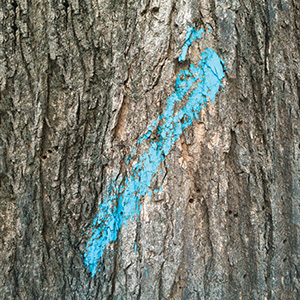 Captiva makes for a consistent, organic work that nicely captures its seaside setting, while Deupree's other new release, the Lost & Compiled collection, has a completely different identity.This collection of unreleased sketches and alternate versions of released songs that differ greatly from what was actually released, and sometimes feature warts and imperfections that makes them all the more endearing.
Captiva makes for a consistent, organic work that nicely captures its seaside setting, while Deupree's other new release, the Lost & Compiled collection, has a completely different identity.This collection of unreleased sketches and alternate versions of released songs that differ greatly from what was actually released, and sometimes feature warts and imperfections that makes them all the more endearing.
The gentle static and subtle melodies of "July 032013" might not be too incongruous with his recent work, but the plucked guitar notes and percussive thuds are more boisterous than I am used to hearing from him, and as a whole it takes on a jazz direction."So Sleepy," an early mix of "For A Morning When," is another moment where Deupree is a standing a bit out of his comfort zone.A sputtering mix of what sounds like bass, synth horns, and processed music box goes in a jerky direction, resulting in a composition that is looser and more erratic than what I expect to hear.
"Journal (Rough)" keeps his penchant for soft and light organic sounds, but within its deconstructed organ-like sounds there is an unexpected appearance of human voice, something Deupree rarely works with in such an obvious context.The shimmering, aquatic sounds of "Sea Last (06.05.08)" result in another piece that takes some unexpected twists, with an interrupting heavy thud and jittery melody that come out of left field.
Captiva might make for the more comprehensive, coherent experience, but Lost & Compiled feels like one made for Deupree's hardcore fans.It admittedly hangs together less effectively as a cohesive album, and I think it is one of the times where it could be best appreciated by someone with a wider familiarity with Deupree's discography.The pieces never go as far as his early flirtations with minimalist techno, but the unexpected and odd directions are best appreciated by those who can tell how different the material truly is.
samples:
 
Read More
- Administrator
- Albums and Singles
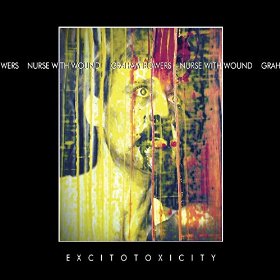 Excitotoxicity is an unwanted process where neurons become over-activated from a surplus of the neurotransmitter glutamate, resulting in cell death and, ultimately, tissue damage and degeneration. Essentially, neurons receive too much stimulation causing the usually well-balanced internal physiology of each cell to become off-kilter and produce excessive levels of harmful molecules that break the neuron down from the inside-out. It is believed to be an underlying part of a number of serious neurological diseases including motor neuron disease, a disease that Graham Bowers has become a victim of. This album is partly a musical diary, an artistic interpretation of neurophysiological processes and a very human response to an unfathomable loss of control.
Excitotoxicity is an unwanted process where neurons become over-activated from a surplus of the neurotransmitter glutamate, resulting in cell death and, ultimately, tissue damage and degeneration. Essentially, neurons receive too much stimulation causing the usually well-balanced internal physiology of each cell to become off-kilter and produce excessive levels of harmful molecules that break the neuron down from the inside-out. It is believed to be an underlying part of a number of serious neurological diseases including motor neuron disease, a disease that Graham Bowers has become a victim of. This album is partly a musical diary, an artistic interpretation of neurophysiological processes and a very human response to an unfathomable loss of control.
ExcitoToxicity’s release comes at a time when mentions of motor neuron disease (MND; or amyotrophic lateral sclerosis, ALS) are running like wildfire through social media thanks to the ice bucket challenge. In contrast to the scores of healthy, young people light-heartedly "raising awareness" about a disease that many cannot describe let alone imagine, this release from Bowers and Steven Stapleton is a quiet and lonely call from the other side of the coin. It is impossible to listen to ExcitoToxicity without taking account of all the contextual information that the album carries with it from the dispassionate facts of how excitotoxicity and disease occur in the body to the highly personal journey that Bowers has found himself traveling upon. "Chains and Gates" begins from an ominous silence before building into a beat and guitar heavy crescendo. The rhythms are sabotaged and pushed into the background by sparks of sound and bell-like interruptions, much like the regular firing of the nervous system becomes dysregulated and disrupted by abnormal activity within itself during neurodegeneration. The album continues in this manner, setting up musical scenarios and dashing them upon the rocks of atonality.
Much like the duo’s first collaboration, Rupture, which dealt with the damage done to the brain through stroke, the idea of the brain as a tightly controlled musical engine (due to its inherent rhythmic activity in the form of brain waves) is used here to demonstrate how delicate this system can be. Throughout ExcitoToxicity, noises begin at low volumes and repeat while simultaneously rising to uncomfortable and almost painful levels. This is a fantastic audiological metaphor for the physiological process of excitotoxicity as neurons fire and fire and fire until they physically break down. More specific references to MND/ALS are made through the titles, "Jack Hammer Mutation"referring to genetic factors associated with the disorder and "Broken Symmetry" reflects the progression of the disease, with paralysis usually developing along one side of the body before crossing over to the other.
Taking all this together as a concept album, it is very clever. Add in the fact that the music is a step up from previous NWW/Bower collaborations (which have been brilliant so far) and this makes for a wonderful release. However, just when I become embroiled enough in the album to get lost in its sounds, I remind myself of Bowers himself going through the emotional and physical turmoil of his body closing in on itself as MND/ALS is a neurological disorder that spares the mind; unlike Alzheimer’s or even extreme Parkinson’s, MND/ALS will destroy the motor system but leave the patient fully aware. Therefore, to think of ExcitoToxicity as purely an art project about a disorder does it a huge disservice, it is also the sound of a man coming to terms with his own mortality and how the rest of his days will be spent. Knowing this makes every second of ExcitoToxicity precious and heavy, heavier than any other recorded work I can think of.
samples:
 
Read More

